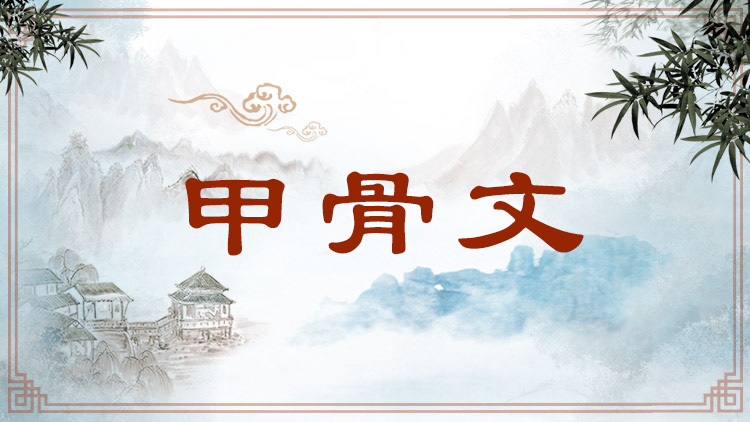甲骨文
Inscriptions on Bones or Tortoise Shells

商周时期用于占卜记事而刻在龟甲或兽骨上的文字,又称“契文”“甲骨卜辞”“殷墟文字”,是中国迄今为止发现的最古老文字,有三千多年历史。甲骨文最初出土于河南安阳的小屯村殷墟,一般认为由晚清金石学家王懿荣于1899年最早发现。商周时期,王室及贵族上自国家大事,下至私人生活,如祭祀、气候、收成、征伐、田猎、病患、生育等,无不向上天卜问,以占卜结果决定行止。占卜是国家政治生活中的一件大事,有刻辞的甲骨,会被当作国家档案保存起来。目前已出土的甲骨达十万余片,发现的甲骨文单字约4500个,其中能认识的字约1700个。甲骨文已经有较严密的系统,汉字的“六书”造字法在甲骨文中都有所体现,而且有大批形声字产生。甲骨卜辞也是今天研究商周时期历史的第一手资料。
Such inscriptions include oracles and events recorded on bones or tortoise shells of the Shang and Zhou dynasties. They are also known as "script chiseled out with a knife," "oracles on bones or tortoise shells," or "script from Yin Ruins." They are the earliest known characters of ancient China dated more than 3,000 years ago. Inscriptions on bones or tortoise shells were first uncovered from among Yin Ruins at Xiaotun Village in Anyang in Henan Province, generally believed to have first been discovered in 1899 by Wang Yirong, a late Qing epigrapher. In the Shang and Zhou dynasties, royal families and noblemen would consult heaven about anything ranging from state business to trivial affairs in daily life, such as sacrificial rituals, weather, harvesting, war, hunting, illness, and giving birth. It was the answers they thus elicited that determined what course of action to take. Divination was an important part of a country's governance; the bones and tortoise shells with characters inscribed on them would be stored away as state archives. So far, more than 100,000 bones and tortoise shells have been unearthed, about 4,500 characters have been tallied, and of these, about 1,700 have been understood and interpreted. Characters on bones and tortoise shells have become increasingly systemized, with the six ways of forming Chinese characters (pictographs, self-explanatory characters, associative compounds, pictophonetic characters, mutually explanatory characters, and phonetic loan characters) all reflected in them and a large number of pictophonetic characters (or phonograms) that had merged. Oracles inscribed on bones and tortoise shells are also valuable firsthand material for studying the history of the Shang and Zhou dynasties.
引例 Citation:
◎卜辞契于龟骨,其契之精而字之美,每令吾辈数千载后人神往。文字作风且因人因世而异,大抵武丁之世,字多雄浑,帝乙之世,文咸秀丽。(郭沫若《殷契粹编·序》)
占卜之辞刻在龟甲兽骨上,其刻工之精、文字之美,每每令几千年之后的我辈神往。卜辞文字的风格也因人因时而异,大体上说,国王武丁时期,文字大多雄浑,国王帝乙时期,文字都很秀丽。
Words of divination, cut out on bones or tortoise shells, are truly admirable for their excellent craftsmanship and fine structures. They fascinate me nonetheless today, although they were the work of several thousand years ago. And they also varied in style from time to time and from person to person. Roughly speaking, the characters of King Wuding's time look majestic whereas those of King Diyi's time look elegant. (Guo Moruo: An Interpretation of Selected Inscriptions on Bones and Tortoise Shells of the Shang Dynasty)
推荐:教育部 国家语委
供稿:北京外国语大学 外语教学与研究出版社
责任编辑:钱耐安





